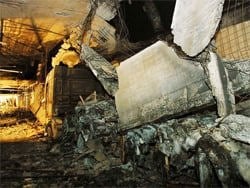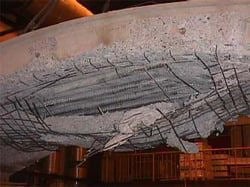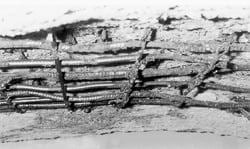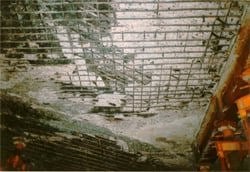
Spalling is an umbrella term, covering different damage phenomena that may occur to a concrete structure during fire. These phenomena are caused by different mechanisms:
- Pore pressure rises due to evaporating water when the temperature rises;
- Compression of the heated surface due to a thermal gradient in the cross section;
- Internal cracking due to difference in thermal expansion between aggregate and cement paste;
- Cracking due to difference in thermal expansion/deformation between concrete and reinforcement bars;
- Strength loss due to chemical transitions during heating.

In different combinations of these mechanisms, possible spalling phenomena include:

Spalling of concrete during fire causes serious damage to concrete structures, with significant economic costs and risk to human life.
New developments in concrete technology like improved grain size distributions and the application of extra fine particles have resulted in concrete types with improved durability, strength and workability. However, these high performance concrete types have shown to be more susceptible to spalling during fire than ordinary concrete types.

The problem of spalling in buildings has been known for decades, but also has been highlighted in recent intense tunnel fires in Europe. As a consequence of severe damage due to spalling and the non-operational time of tunnels after a fire, the fire resistance of newly developed concrete types has been questioned.
During fire tests the observations of spalling of concrete cover a wide range, in random order: observation of spalling with slow (1ºC/min.) or fast (250ºC/min.) heating, from gradual to explosive spalling, cracking along or through aggregate grains, spalling in the beginning of the fire or after some time, stopping after some time or progressing, stopping at the reinforcement level or continuing far beyond it, and so on.
In the paragraphs below the different observed spalling phenomena are described and related to these mechanisms, see also Breunese and Fellinger (2003).
A summary of these relations is given in the table below.
| Pore pressure due to evaporation of moisture | Compression due to thermal gradient | Internal cracking due to different thermal expansion aggregate - cement paste | Cracking due to different thermal deformation concrete - steel | Strength loss due to chemical transitions | |
| Violent Spalling | x | x | x | ||
| Sloughing Off | x | x | |||
| Corner Spalling | x | ||||
| Explosive Spalling | x | x | |||
| Post-Cooling Spalling | x | x |
Violent spalling
Violent Spalling is the separation of small or larger pieces of concrete from the cross section, during which energy is released in the form of popping off of the pieces and small slices with a certain speed, and also a popping or cracking sound.This type of spalling is caused by pore pressure and thermal gradients; internal cracking on the meso-level also influences this spalling process.
The surface compression during heating can increase due to lateral restraint, reinforcement, prestressing, large concrete thickness and a high heating rate.
Pore pressures are dependent on heating rate, moisture content, permeability, porosity and the presence of polypropylene fibres (artificial permeability).
Furthermore, an increased ductility of concrete by steel fibres has sometimes been reported to reduce the risk of this type of spalling, Fellinger and Both (1997).
Progressive Gradual Spalling (Sloughing Off)
Sloughing Off is the form of spalling that is caused by strength loss due to internal cracking (mesolevel) and chemical deterioration of the cement paste (micro-level).This type of spalling is related to the attained temperature of the concrete (instead of heating rate).
If the concrete is heated to a very high temperature the strength will be too low to carry its own weight, causing small pieces of concrete to fall down without much sound.
This type of spalling is likely to occur on a slab heated from below, since gravity will pull the cracked pieces of concrete from the cross section.
Corner Spalling
Corner Spalling is the type of spalling that occurs when a corner of concrete breaks off at the location of a reinforcement bar.Inhomogeneous heating of concrete leads to a deformation (ovalisation) of the concrete around the uniformly heated reinforcement bar.
This difference in deformation causes splitting stresses in the concrete, leading to splitting cracks that can cause the corner of a column or slab to break off.
Explosive Spalling
Explosive Spalling is the result of a combination of rising pore pressures and thermal gradients in the cross-section.At the front of heat penetration, a “moisture clog” (area with high pore pressure) develops inside the concrete.
Part of the moisture is pushed further into the colder part of the concrete due to the pressure gradient at the back of the clog.
If the heated surface is under compression due to a thermal gradient the complete heated surface may be blown away with a loud bang.
This type of spalling is especially likely to occur on structural members heated from more than one side, such as columns and beams.
When moisture clogs are advancing into the concrete from all heated sides, at some point in time the moisture clogs will meet in the centre of the cross-section, giving a sudden rise in pore pressure which may cause large parts of the cross-section to explode.
This type of spalling can also occur after a considerable duration of the fire if the concrete surface has been protected with an insulating layer, Both (1999).
Post-Cooling Spalling
Post-Cooling Spalling occurs after the fire is over, after cooling down or maybe even during extinguishing, Khoury (2003).This type of spalling was observed with concrete types containing calcareous aggregate.
An explanation is the rehydration of CaO to Ca(OH)2 after cooling, with an expansion of over 40%. This occurs after cooling down, when moisture is again present on the concrete surface.
The expansion due to rehydration causes severe internal cracking on the meso-level and thus complete strength loss of the concrete.
Pieces of concrete keep falling down as long as there is water to rehydrate the CaO in the dehydrated zone.
Promat Technical Support
Contact our technical support team with your questions on passive fire protection solutions, our products and systems or installation advice...
Technical Documentation
Find the product datasheets, system brochures, Declarations of Performance, installation manuals and other documents you need to get the job done.